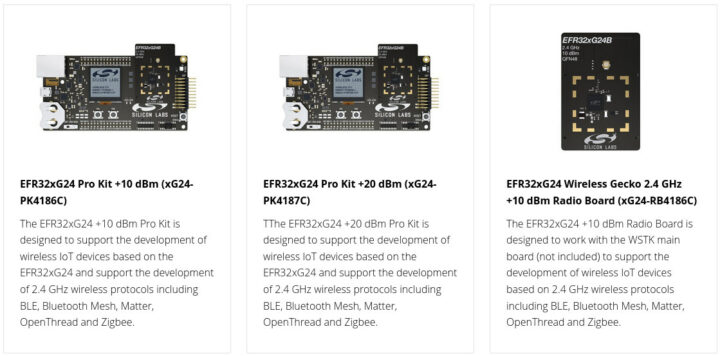Machine Learning is getting everywhere including into 2.4GHz wireless microcontrollers with SIlicon Labds BG24 Bluetooth and MG24 multi-protocol Cortex-M33 microcontrollers that improve AI/ML performance by 4 times using 1/6th of the energy thanks to a built-in AI accelerator.
That makes the new microcontrollers suitable for battery-powered edge AI devices with support for Matter (coming soon) as well as PSA Level 3 Secure Vault protection. Silicon Labs expects the chips to be found in various smart home, medical and industrial applications.
BG24 and MG24 share the same block diagram and the same specifications apart from the supported wireless protocols:
- MCU core – Arm Cortex-M33 @ 78.0 MHz with DSP instruction and floating-point unit
- Memory – Up to 256 kB RAM data memory
- Storage – Up to 1536 kB flash program memory
- Wireless
- CPU – Arm Cortex-M0+
- 2.4 GHz Radio Performance
- -104.5 dBm sensitivity @ 250 kbps O-QPSK DSSS
- -104.9 dBm sensitivity @ 125 kbps GFSK
- -97.5 dBm sensitivity @ 1 Mbit/s GFSK
- -94.4 dBm sensitivity @ 2 Mbit/s GFSK
- TX power up to 19.5 dBm
- Supported protocotols
- BG24 – Bluetooth Low Energy (Bluetooth 5.2) and Bluetooth Mesh
- MG24 – Matter, OpenThread, Zigbee, BLE, Bluetooth Mesh, Proprietary 2.4 GHz, Multiprotocol
- Supported Modulation Format
- 2x (G)FSK with fully configurable shaping
- (G)MSK
- MG24 only – OQPSK DSSS
- Peripherals
- Analog to Digital Converter (IADC) 12-bit @ 1 Msps or 16-bit @ 76.9 ksps
- 2x Analog Comparator (ACMP)
- 2x Digital to Analog Converter (VDAC)
- Up to 32x General Purpose I/O pins
- 8-channel DMA Controller (LDMA)
- 16-channel Peripheral Reflex System (PRS)
- 3x 16-bit Timer/Counter, 2x 32-bit Timer/Counter
- 32-bit Real Time Counter (SYSRTC)
- 24-bit Low Energy Timer for waveform generation (LETIMER)
- 16-bit Pulse Counter with asynchronous operation (PCNT)
- 2x Watchdog Timer (WDOG)
- 1x USART supporting UART/SPI/SmartCard (ISO 7816)/IrDA/I2S
- 2x Enhanced USART supporting UART/SPI/DALI/IrDA
- 2× I2C interface with SMBus support
- Low-Frequency RC Oscillator with precision mode to replace 32 kHz sleep crystal (LFRCO)
- Keypad scanner supporting up to 6×8 matrix (KEYSCAN)
- Die temperature sensor
- Supply voltage – 1.71 V to 3.8 V single power supply
- Power consumption
- 4.4 mA RX current (1 Mbps GFSK)
- MG24 only – 5.1 mA RX current (250 kbps O-QPSK DSSS)
- 5.1 mA TX current @ 0 dBm output power
- 20 mA TX current @ 10 dBm output power
- 155 mA TX current @ 19.5 dBm output power
- 33.4 μA/MHz in Active Mode (EM0) at 39.0 MHz
- 1.3 μA EM2 DeepSleep current (16 kB RAM retention and RTC running from LFRCO)
- Temperature Range – -40 °C to 125 °C
- Packages
- QFN40 5 x 5 x 0.85 mm
- QFN48 6 x 6 x 0.85 mm
Silicon Labs also works with partners to add an AI/ML toolchain to Simplicity Studio for support for Tensorflow, as well as SensiML and Edge Impulse solutions which can help bring ML solutions to market easily and quickly. EFR32xG24 PRO development kit with either +10 or +20 dBm Tx power will soon be available publicly.
The company has already been working with over 40 companies in a closed Alpha program working on Matter support and solutions making use of the new machine learning capabilities of the 2.4GHz wireless MCU. These will notably be used by retailers to “improve the in-store shopping experience” with more accurate asset tracking, and real-time price updating, while the commercial building management sector aims to lower the costs and environmental footprint with better management of lighting and HVAC for instance.
Silabs EFR32BG24 and EFR32MG24 SoCs are already shipping today to Alpha customers, with mass deployment slated for April 2022. Multiple evaluation boards are also said to be available according to the press release, but the product pages still show those are “coming soon”. BG24 and MG24 modules are also expected, but later in H2 2022.
Thanks to TLS for the tip.

Jean-Luc started CNX Software in 2010 as a part-time endeavor, before quitting his job as a software engineering manager, and starting to write daily news, and reviews full time later in 2011.
Support CNX Software! Donate via cryptocurrencies, become a Patron on Patreon, or purchase goods on Amazon or Aliexpress





